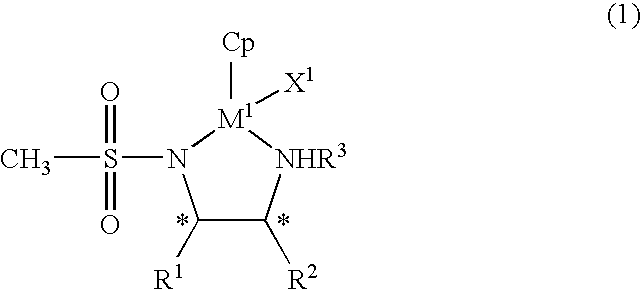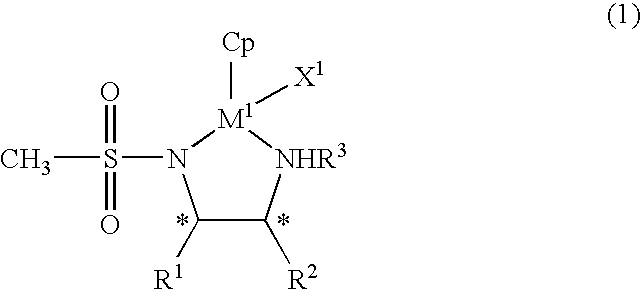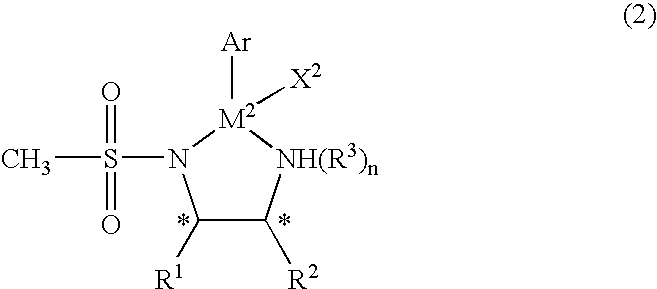Organic metal compound and process for preparing optically-active alcohols using the same
a technology of organic metal compounds and alcohols, which is applied in the direction of organic compounds/hydrides/coordination complexes, physical/chemical process catalysts, organic reduction, etc., can solve the problems of insufficient enantiomeric excess, insufficient enantiomeric excess, and insufficient enantiomeric excess, etc., to achieve high purity, high yield, and high efficiency
- Summary
- Abstract
- Description
- Claims
- Application Information
AI Technical Summary
Benefits of technology
Problems solved by technology
Method used
Image
Examples
example 1
Synthesis of Cp*IrCl[(S,S)-MsDPEN]
[0053]319 mg (1.10 mmol) of (S,S)-MsDPEN (MW: 290.4) and 398 mg (0.5 mmol) of [Cp*IrCl2]2 (MW: 796.6) were introduced in a 50 mL Schlenk tube, and the mixture was subjected to argon substitution. 15 mL of 2-propanol was added and dissolved, then 0.3 mL (2.2 mmol) of triethylamine and 2 mol equivalents of (S,S)-MsDPEN were introduced, and the resulting mixture was stirred at room temperature for 7 hr. After the solvent was distilled off under reduced pressure, 15 mL of methylene chloride was added, and the resulting methylene-chloride solution was transferred to a separating funnel and washed with the addition of 20 mL of water. The aqueous phase was extracted three times with 15 mL of methylene chloride and combined with the organic phase. 5 g of Na2SO4 was added and the resulting mixture was stirred for a while, then the supernatant was filtered through a glass filter, and the filtrate was transferred to a 100 mL eggplant-shaped flask. Na2SO4 was w...
example 2
Synthesis of Cp*IrCl[(S,S)-MsCYDN]
[0056]500 mg (2.60 mmol) of (S,S)-MsCYDN (MW: 192.3) and 1.035 g (1.30 mmol) of [Cp*IrCl2]2 (MW: 796.6) were introduced in a 50 mL Schlenk tube, and the mixture was subjected to argon substitution. 25 mL of 2-propanol was added and dissolved, then 0.72 mL (5.2 mmol) of triethylamine was introduced, and the resulting mixture was stirred at room temperature for 0.5 hr. After the solvent was distilled off under reduced pressure, the obtained residue was washed in 20 mL of diisopropylether. The solvent was distilled off under reduced pressure to give 1.88 g (65 wt % content) of Cp*IrCl[(S,S)-MsCYDN] in which 2.9 equivalents of triethylamine (including triethylamine hydrochloride) is coordinated to the complex. Yield: 85%.
[0057]1H NMR (400 Mz, CDCl3) δ (ppm) 1.2-2.2 (m, 8H, C6 ring), 1.41 (t, Et3N), 1.67 (s, 15H, C5(CH3)5), 1.83 (s, 3H, CH3 of Ms), 2.64 (brd, 1H, NH2), 2.84 (brd, 1H, NCH), 3.10 (q, Et3N), 3.4 (m, 1H, NH2), 3.4 (m, 1H, SO2NCH) 4.35 (m, 1H...
example 3
Synthesis of Cp*RhCl[(R,R)-MsDPEN]
[0059]470 mg (1.62 mmol) of (R,R)-MsDPEN (MW: 290.4) and 500 mg (0.809 mmol) of [Cp*RhCl2]2 (MW: 618.08) were introduced in a 50 mL Schlenk tube, and the mixture was subjected to argon substitution. 15 mL of 2-propanol was added and dissolved, then 0.45 mL (3.2 mmol) of triethylamine was introduced, and the resulting mixture was stirred at room temperature for 7 hr. After the solvent was distilled off under reduced pressure, 15 mL of methylene chloride was added, and the resulting methylene-chloride solution was transferred to a separating funnel and washed with the addition of 20 mL of water. The aqueous phase was extracted three times with 15 mL of methylene chloride and combined with the organic phase. 5 g of Na2SO4 was added and the resulting mixture was stirred for a while, and the supernatant was filtered through a glass filter, and the filtrate was transferred to a 100 mL eggplant-shaped flask. Na2SO4 was washed twice with 20 mL of methylene ...
PUM
| Property | Measurement | Unit |
|---|---|---|
| temperature | aaaaa | aaaaa |
| optical purity | aaaaa | aaaaa |
| optical purity | aaaaa | aaaaa |
Abstract
Description
Claims
Application Information
 Login to View More
Login to View More - R&D
- Intellectual Property
- Life Sciences
- Materials
- Tech Scout
- Unparalleled Data Quality
- Higher Quality Content
- 60% Fewer Hallucinations
Browse by: Latest US Patents, China's latest patents, Technical Efficacy Thesaurus, Application Domain, Technology Topic, Popular Technical Reports.
© 2025 PatSnap. All rights reserved.Legal|Privacy policy|Modern Slavery Act Transparency Statement|Sitemap|About US| Contact US: help@patsnap.com



